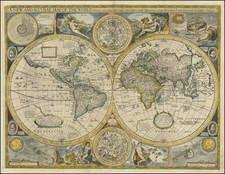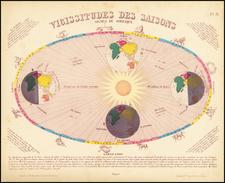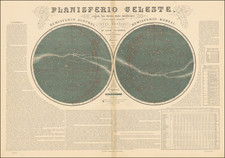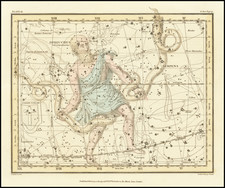Nice example of the first edition of Speed's double hemisphere map of the World, bearling the name George Humble.
Speed's map is based upon Grent's extremely rare map of the world published in London and on Jodocus Hondius' map of 1617, which most notably contributes the allegorical repersentations of Water, Fire, Land and Earth. The map is one of the earliest attainable world maps printed in English. The map shows California as and Island, an unusual Northwest Coast of America, conjectural Magellanica or The Southerne Unknowne Land and extraordinary early detail throughout the map. It is surrounded by smaller celestial hemispheres, figural representations of Water, Earthe, Aire and Fire, a number of celestial phenomena & portraits of early explorers. Includes several lengthy notes on the South Pole & Straits of Magellan.
Unlike most of Speed's maps, the map was likely not prepared by Speed, but was in fact the work of the publisher George Humble, whose name also appears on he first edition of the map. Shirley noted that the style is consistent with the work of Abraham Goos, who engraved several other maps for Speed's Prospect of the most Famous Parts of the World. This first edition was used until the Prospect was re-issued by Humble's son William and the date changed to 1651.
John Speed (1551 or '52 - 28 July 1629) was the best known English mapmaker of the Stuart period. Speed came to mapmaking late in life, producing his first maps in the 1590s and entering the trade in earnest when he was almost 60 years old.
John Speed's fame, which continues to this day, lies with two atlases, The Theatre of the Empire of Great Britaine (first published 1612), and the Prospect of the Most Famous Parts of the World (1627). While The Theatre ... started as solely a county atlas, it grew into an impressive world atlas with the inclusion of the Prospect in 1627. The plates for the atlas passed through many hands in the 17th century, and the book finally reached its apotheosis in 1676 when it was published by Thomas Bassett and Richard Chiswell, with a number of important maps added for the first time.










![[ World Map Facsimile ] Typus Universalis Terrae, Iuxta Modernorum Distinctionem et Extensionem Per Regna et Provincias](https://storage.googleapis.com/raremaps/img/small/95596.jpg)
![[ World on Mercator's Projection ] Mappe-Monde suivant la projection de Mercator -- 1832](https://storage.googleapis.com/raremaps/img/small/99031.jpg)


![Globi Coelestis In Tabulas Planas Redacti Pars I. . . [ Ursa Major, Camelopardius, Lynx S. Tigris, Cassiopea, Cepheus, Draco, and Ursa Minor ]](https://storage.googleapis.com/raremaps/img/small/71118.jpg)
